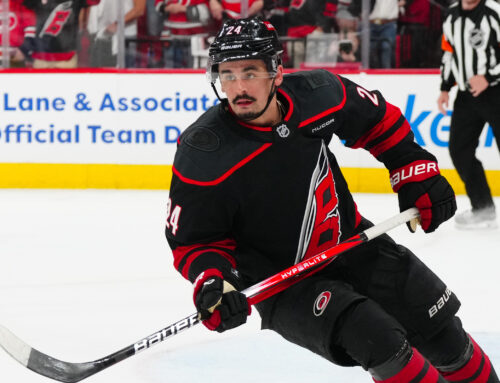
We often use stock market jargon when discussing the game of hockey. A player’s stock is rising or falling, buy low, sell high, blue chip prospect, etc. Not surprisingly, both the NHL and its players frequently refer to hockey as a business.
Sometimes I wish I could muster half the interest in the stock market as I can in hockey. Wouldn’t time spent trying to figure out which health stock is going to find the cure for (insert disease/affliction here) instead of trying to determine the status of Gaborik’s groin or Havlat’s shoulder?
I should have been buying oil stocks before they went sky-high, instead of selling my Oilers after they crashed and burned last year. My idea of timing the market is knowing what round to select Daniel Carcillo or Mike Green.
Here are some stock market definitions that could easily apply to fantasy hockey:
Blue Chip Stocks – Stocks of leading and well-known companies that have a record of continuous strong performance. Players like Mats Sundin, Marian Hossa, Sergei Gonchar or Martin Brodeur are examples of blue chip stocks.
Continuous Disclosure – A company’s ongoing obligation to inform the public of significant corporate events, both favourable and unfavourable. The NHL does not subscribe to this policy. Often we find players listed as out for 2-4, 4-6 or 6-8 weeks, as well as the ever helpful day-to-day or indefinite. All that to say, the NHL is not very forthcoming with information on injured players and it can make choosing a line-up for the week difficult.
Cyclical Stock – A stock of a company in an industry sector that is particularly sensitive to swings in economic conditions. The poster child for this term is Vaclav Prospal with seasons of 55, 80, 54, 79 and 55 points. Players in contract years would also fall into this category.
Delist – The removal of a security’s listing on a stock exchange. Consider Jason Allison and Jeff O’Neill as delisted.
Diversification – Limiting investment risk by purchasing different types of securities representing different sectors of the economy. If you have two players with a penchant for being injured like Gaborik or Havlat on your roster, getting someone like Olli Jokinen or Marian Hossa, who always seems to play 80 games a year would be called diversifying. In a rotisserie pool, if you have Joe Thornton, Brad Richards and Henrik Sedin on your team, you will need to diversify and grab some goal scorers in order to balance all those assists.
Growth Stock – The shares of companies that have enjoyed better than average growth over recent years and are expected to continue their climb. Alexander Ovechkin, Evgeni Malkin, Nathan Horton and Ryan Whitney would fit in this category.
Hedge – A strategy used to limit investment loss by making a transaction that offsets an existing position. If you own Toskala, then taking Raycroft would be your hedge against poor performance by Toskala. Same goes for Emery (Gerber) and Backstrom (Harding) owners.
Initial Public Offering (IPO) – An IPO is an issuer’s first offering of its securities made to the public. In fantasy hockey, this is called a Prospect or Entry Draft.
Penny Stock – Low-priced speculative issues of stock selling at less than $1.00 a share. Marcel Hossa, Milan Lucic, David Krejci, Simon Gamache or Brett Sterling come to mind.
Prospectus – A legal document describing securities being offered for sale to the public. A fancy way to describe hockey pool magazines.
Rally – A brisk rise in the general price level of the market or price of a stock. In the East, think Martin Gerber, Cam Ward, Nik Antropov, Brian Campbell, Mike Comrie or Ruslan Fedotenko.
Risk – The future chance or probability of loss. Drafting a Coyote, Thrasher or a King in a pool that counts plus/minus, might be the very definition of risk in fantasy hockey.
Short Selling – The selling of a security that the seller does not own. Short sellers assume the risk that they will be able to buy the stock at a lower price, sell it later and realize a profit from the difference. You acquire a player whose stock is low with the intention of trading him for more later in the season. This term would fit if you make a deal speculating that a player is going to get moved to a better situation later in the season. For example, getting Bryzgalov or Jovanovski and hoping they are dealt to another team. Many poolies acquired Martin Biron for that very reason last year before he was traded to the Flyers.
Next week, I will give you my first Beast from the East. It will be the Eastern Conference’s answer to Angus’ Prime Cut that appears in the Wild West every second week.
LEAVE FEEDBACK FOR THIS ARTICLE HERE





 FLA
FLA EDM
EDM MIN
MIN BUF
BUF NYR
NYR CHI
CHI OTT
OTT L.A
L.A UTA
UTA MTL
MTL VAN
VAN
